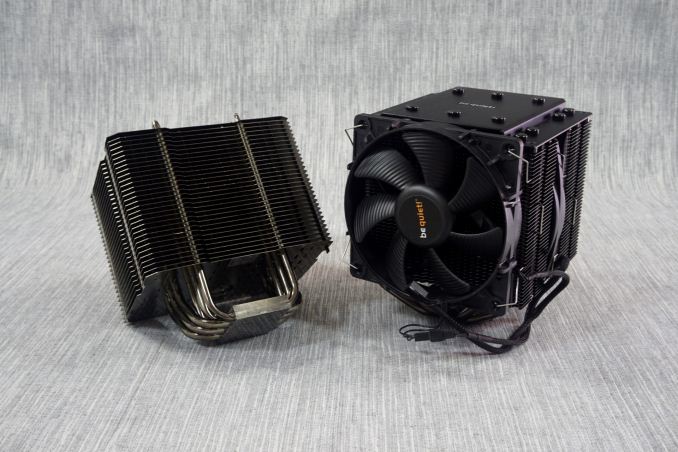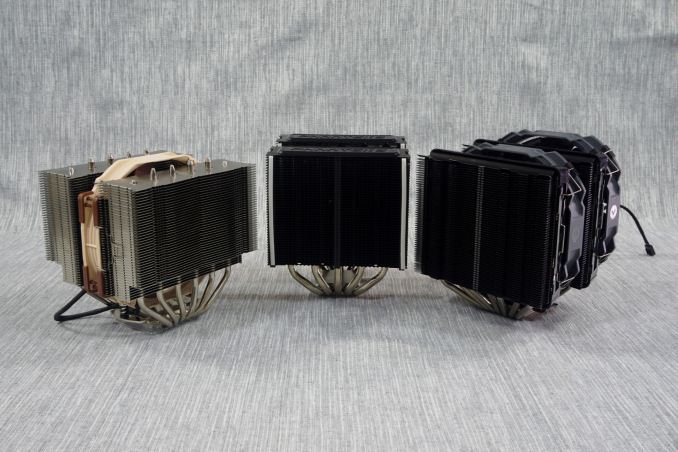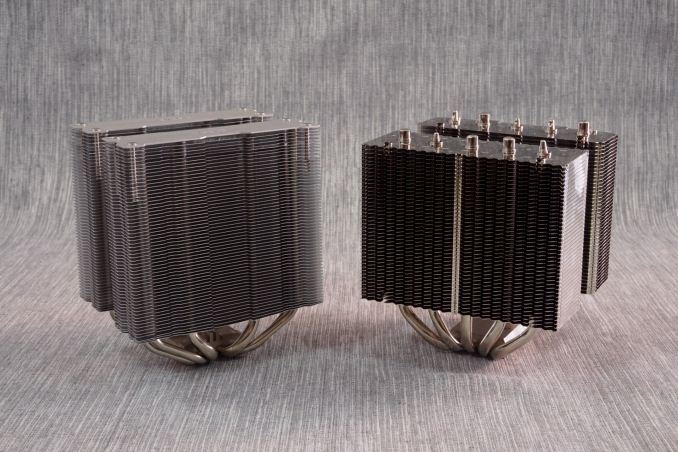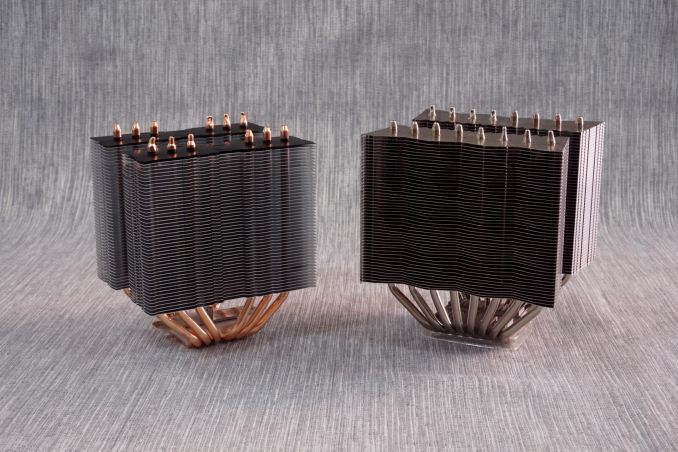Top Tier CPU Air Coolers Q3 2015: 9-Way Roundup Review
by E. Fylladitakis on July 6, 2015 8:00 AM ESTConclusion
It goes without saying that the selection of a CPU cooler is not easy. Each user has different requirements and needs. Even if we select a very specific group, such as those who are seeking the best air-based cooling solutions possible, there are different levels of tolerance to noise and different budgets. Furthermore, certain coolers could cause compatibility problems with the case or the RAM. All performance and physical aspects need to be taken into account by each individual user, weighing which option is the best for a specific application.
If thermal performance were the top priority, it would be very difficult to select between the Noctua NH-D15, the Cryorig R1 Ultimate, the Phanteks TC14PE and the Raijintek Tisis. All four of these coolers have similar thermal performance overall, with the Tisis and the NH-D15 showing a little better performance at lower loads and slightly lower noise levels. All four of these coolers are of comparable manufacturing quality as well; at least as long as the body of the cooler is concerned. A selection between these four coolers generally becomes a matter of compatibility, availability and pricing.
Noctua and Phanteks are known for their support and their willingness to offer mounting kits for new sockets, plus their design allows their front fans to be raised and increase the RAM clearance, gaining several points on compatibility. Cryorig's R1 Ultimate is visually very lustrous but its availability is extremely low. Furthermore, its plastic frame design prevents the fan to be moved up more than a few mm's, limiting RAM compatibility beneath the cooler. The Raijintek Tisis has the advantage of lower pricing but its availability is limited and its fans cannot be adjusted in terms of height at all.
When thermal performance becomes the only priority, the Reeven Okeanos overtakes the competition through sheer force. The relatively small and simple cooler hits the top of our thermal resistance charts, demonstrating the best thermal performance of this roundup review. However, this performance is solely based on its high speed fans, making the Okeanos by far the loudest cooler of this review as well. Furthermore, its availability is very low as Reeven still has very low market penetration and production. It would be easy to recommend the Okeanos to those who do not care about noise at all, but the blunt truth is that everyone does care about noise. It may not be the first priority but it definitely is a major selling factor, as nobody likes a noisy device, limiting the potential of the Okeanos.
Be Quiet!'s Dark Rock Pro 3 is clearly designed with acoustics and quality as the priorities, which generally are the focus and trademark of the company. It may be falling a little behind on thermal performance but it does deliver the promised lower noise levels. Furthermore, it is a high quality construct and comes with very high quality fans, improving its competitiveness. The acoustics performance of the Dark Rock Pro 3 is only challenged by the irregularity of our review, the Thermalright Macho Zero, a cooler designed for very low airflow environments. When paired with Thermalright's own TY-147A fan, the Macho Zero cannot offer the same thermal performance as the rest of the coolers but it is practically noiseless. Its wide fin spacing has very low airflow impedance, making the cooler optimized for semi-fanless operation. This means that the Macho Zero is designed to rely on the airflow of a case and operate without a fan at all, or to operate with a high-CFM case fan installed on it. Because of the low airflow impedance, the noise level of the Macho Zero is notably lower than that of conventional coolers, while it does offer good thermal performance. For those that acoustics are a primary concern, the Macho Zero definitely holds a major advantage.
The last two coolers of this review are the SlientiumPC Grandis XE1236 and the Deepcool Assassin. The former is by far cheaper than any other solution of this review and, considering its thermal performance, we wonder if it would be more reasonable to compare it against middle-range coolers, not the largest and mightiest behemoths out there. The only real comparison with the rest of the coolers in this review is its size and dual tower design. SilentiumPC however does not exaggerate, openly claiming that the primary design factor of their products is cost. True enough, the Grandis XE1236 is very competitively priced and offers acceptable overall performance, making it a very interesting solution for users on a tight budget. The Deepcool Gamerstorm Assassin is a more complicated matter. The design, size and, until recently, the price of this cooler were hinting that the Assassin is on par with the best coolers out there. However, despite its grandiose appearance, the Assassin generally fails to impress and it would be in great trouble if a massive price cut would not take place just a few days ago. With its retail price reduced by 25-30%, the Assassin becomes a viable solution, competing in terms of value rather than performance, making it a higher quality solution over the Grandis at an acceptable cost.
Ultimately, if our conclusions could be summarized in a single table, it would be this:
| 9-Way CPU Cooler Quick Conclusions | |||
| Priority | Cooler | Reason | |
| Best Thermal Performance |
Noctua NH-D15 $93 |
Reeven Okeanos 60€ (≈$54*) |
If raw thermal performance is the only concern, these two air-based coolers offer the best there is. Arguably, the Okeanos is far too loud but, even though the high performance solely comes from strong fans, it retails for nearly half the price of the NH-D15. Therefore, the final selection depends on secondary targets and the budget. |
| Quietest | Thermalright Macho Zero $65 (no fan) |
Be Quiet! Dark Rock Pro 3 $86.50 |
When low noise is the primary selection factor, Thermalright wins hands down. Be Quiet!'s Dark Rock Pro 3 would be our next choice, as it is a complete solution with fans and offers better thermal performance at comparatively low noise levels. |
| Best Value | SilentiumPC Grandis XE1236 £34.90 (≈$45*) |
Phanteks TC14PE $80 |
Out of the nine coolers of this review, the Grandis may not be the best performer but it is by far the cheapest. For those that are satisfied with good performance and just want a good cooler, it will not disappoint. For those in the US, Phanteks' TC14PE offers very good quality and performance at a competitive price. |
| Realistic selection (or what I, as an enthusiast/overclocker, would buy) |
Noctua NH-D15 $93 |
To my eyes, Noctua's NH-D15 is the most balanced product of this review. It offers excellent thermal performance at reasonable noise levels, the quality is exceptional, all while the retail price is not extravagant. | |














135 Comments
View All Comments
Narcissist - Tuesday, July 14, 2015 - link
I fully agree with the Oxford Guy. I've got a NoFan CR-95C cooling my non-OC i7 4790K. This in conjuction with a couple of M.2 SSD-units, a passively cooled PSU and a passively cooled graphics card makes for a 100% quiet and rather powerful computer. To be on the safe side I've added a Noctua D14 which is configured to force air across all components when the motherboard temperature gets over 50 degC. I is almost never active, though. I've run the Prime95 "Torture Test" for prolonged periods but the CPU-temp consistently stays below 70 degC. In my opinion the NoFan unit is doing a splendid job, although at a price.Sivar - Friday, February 5, 2016 - link
Listen to Oxford Guy. I've used three NoFan models and they all work amazingly well...as long as your CPU's power consumption stays under 100W. If you use a 6- or 8- core i7, or if you overclock enough to hit the 100W envelope, fanless is not for you.Note that NoFan coolers benefit only slightly when a fan is used. They are truly built as fanless coolers from the ground up.
lagittaja - Monday, July 20, 2015 - link
My HTPC has a G2120 with NH-U12P, HD5670 with Accelero S1r2, 64GB Samsung 830 + 1TB WD Black along with 80+ Plat 400W fanless PSU. Inside Lian Li A05N.Only fans being filtered intake Gentle Typhoon @~600rpm and exhaust Slip Stream ~400rpm.
Pretty overkill cooling wise. Could drop the fan speeds even further..
To answer your question, yes it can easily handle it provided there's a teeny weeny bit of airflow in the case.
Work rig has a HR-02 Macho with 800rpm Slip Stream cooling a 3770K@4.7Ghz/1.336V. Could run it fanless if I'd drop the clocks to say 4.3/1.1 or so..
Cvengr - Friday, December 25, 2015 - link
It would simply be the ratio of surface area of the fins to the surface area of the top of the CPU making contact with the heat collector. The fans merely dissipate the heat more quickly over the same area.The advantage of the fans are to transfer the heat by convection to the outer environment more quickly than allowing the heat to build up closer to other components in the system.
If designed for heat transfer, the other components are likely to have been designed assuming an ambient temperature at a particular max level, say 100-130degF. As the delta Temp between the environment and the part generating the heat will increase, so will the heat flow by conduction.
Intent is to draw the heat as far away from the components as possible.
One problem in these designs is to get the heat away from the CPU, as well as the Motherboard components, as well as other components in the case, so the interior case temperatures don't approach the environmental max design temps of those components.
A disadvantage in building by components, is that the component manufacturers are likely to only design for their particular component or one they support.
A common problem in Data Centers is how to remove all the heat from the racks and equipment within them. ANSI/TIA 942 stds go a long way to coordinate between disciplines and trades to effect proper HVAC in the server areas, but even within the racks and cabinets, too many designs limit themselves to providing a temperature set point at different areas in the room, but fail to flow adequate air over the equipment to transfer the heat away from the local electronics environments.
Computer Room Air Conditioners (CRAC) units are notorious for being installed to remove heat, but fail to provide adequate ventilation (air movement) within the computer rooms.
Since most of the CRAC units use split systems (condensate lines in 1/2" copper tubing running through the wall to a condenser outside the building), The natural trend would be to incorporate a small heat exchanger using a CPU water cooling fluid as the secondary, and the chilled water from the condensate of a HVAC system as the primary chilled water to remove the heat.
I haven't shopped the Enterprise level systems. I wonder if such systems are commodities.
sjakti - Monday, July 6, 2015 - link
Interesting article, thank you! I especially appreciate the "Quick Conclusions", that's a great table.Shadow7037932 - Monday, July 6, 2015 - link
I wish you guys had included the Hyper 212+/EVO in the review as the base comparison.zodiacfml - Monday, July 6, 2015 - link
True. It should be the default heatsink to compare with. Now that majority of Intel's CPUs become low power and efficient, these dual tower designs seem overkill except for the unlocked multiplier overclocker or fanless PCs.Achaios - Monday, July 6, 2015 - link
Obsession with CM Hyper 212 EVO "Hypertwohundredtwelvetitis" is a disease also prevalent in Overclock.net. People go berserk over the 212, almost as if they have been mass brainwashed or mass hypnotized. To my best understanding, this mass hysteria is due to the fact that cheap "enthusiasts" may save up to the hugely important sum of $9.99 if they go with the 212 compared to other coolers for the wondrous performance gain of 0.8 Celsius. In other words, the mass hysteria with the 212 is because if you go with the 212, you will save enough money in the end to buy a pack of cigarettes and a can of beer.Nagorak - Monday, July 6, 2015 - link
Well every little bit counts, and to be honest I can understand why people would not want to spend $70-$80 on a heatsink. Getting a decent heatsink for $30-$40 makes sense for a lot of people. However, if you consider wasting money buying cigarettes to be reasonable, I can understand why you wouldn't put much stock in saving a few bucks.Achaios - Monday, July 6, 2015 - link
Given how many overclockers and enthusiasts actually use the CM Hyper Evo 212 in their rigs (as eveidenced at Overclock.net) I think that Zodiacfml's suggestion of the CM hyper Evo 212 being used as a baseline cooler is a good one and I recommend the OP to take it.